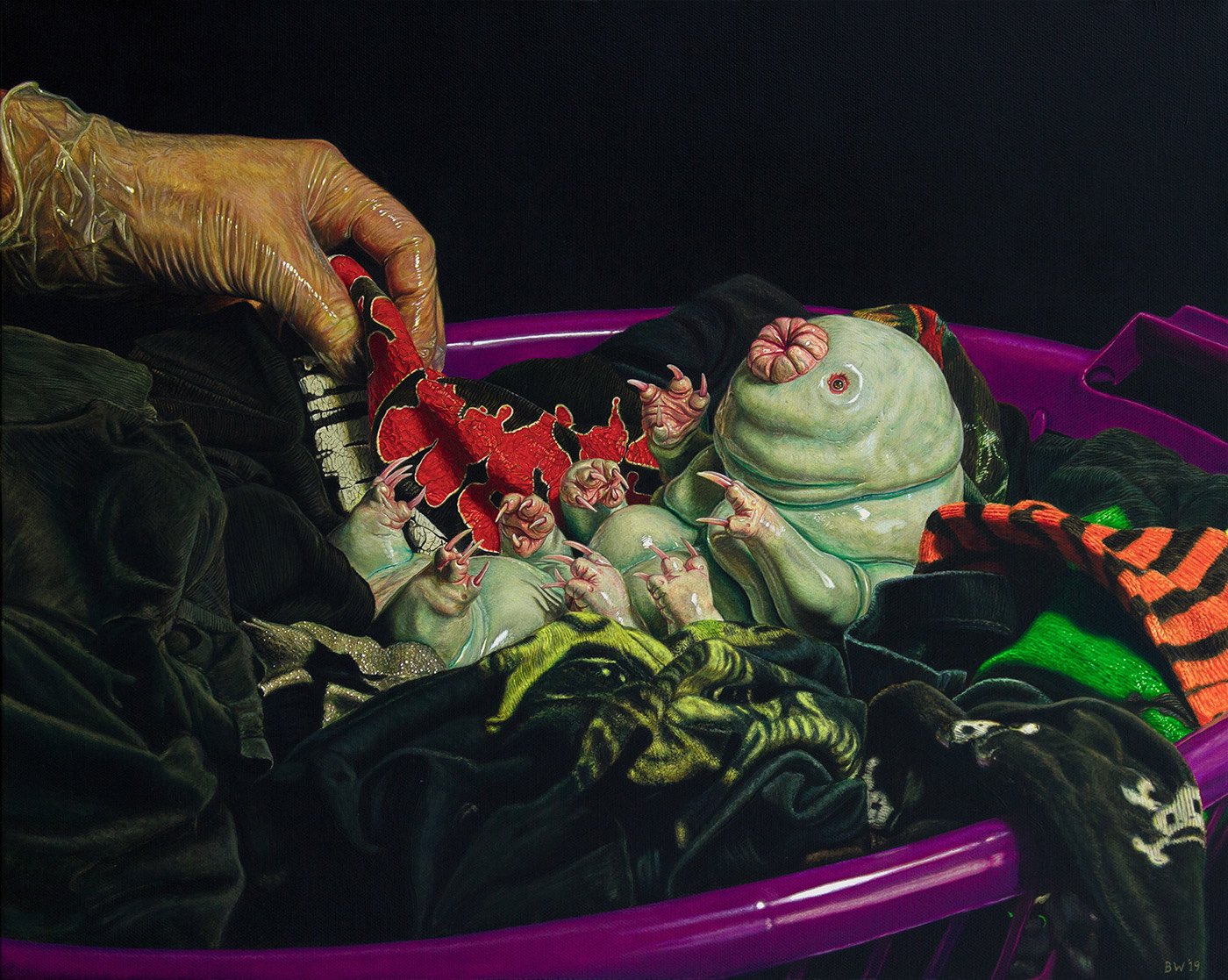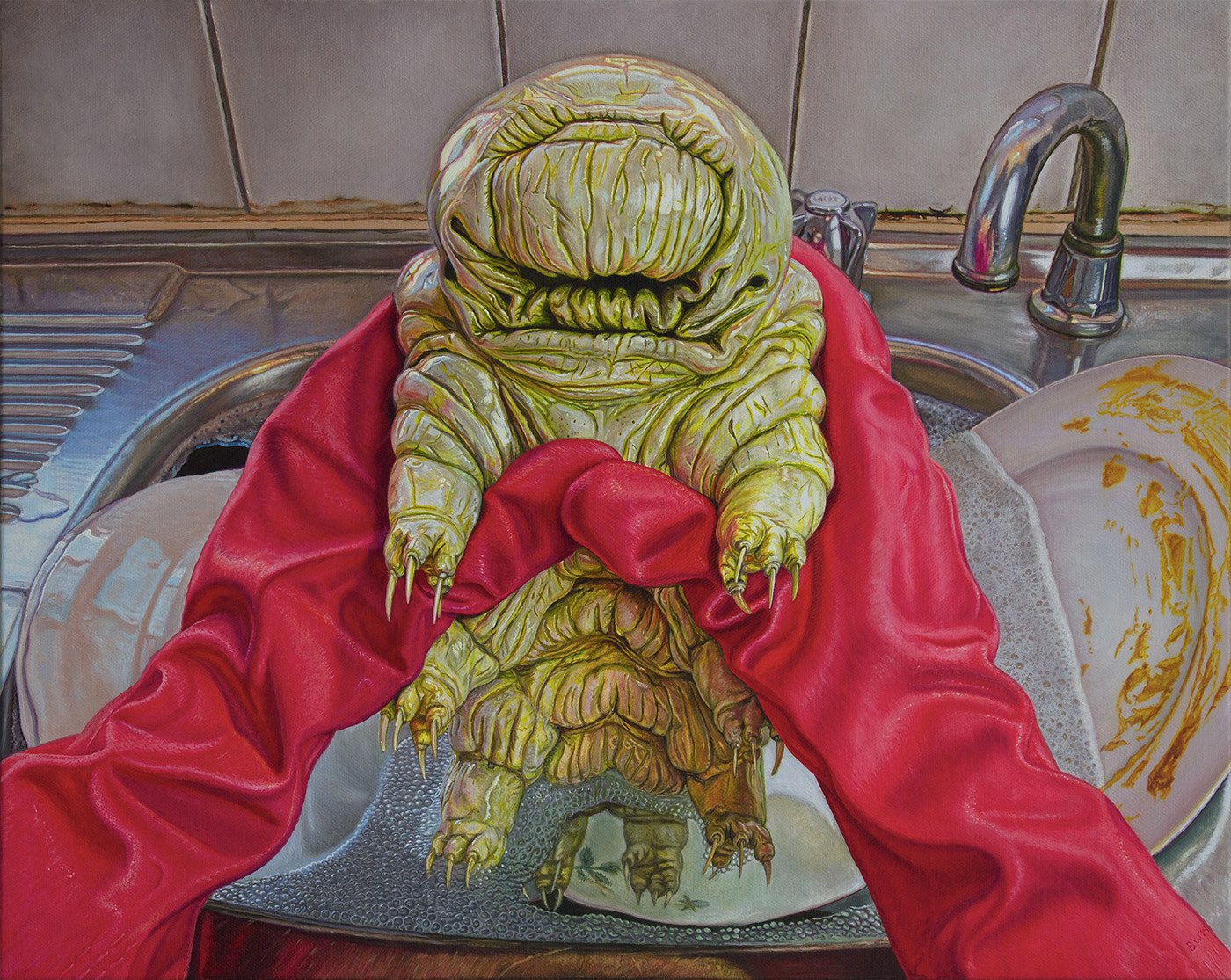They’re called tardigrades, but they’re more adorably known as moss piglets or water bears. These are a division of eight-legged water-dwelling micro-animals found in most earthly environments, from the bottom of the deepest oceanic trenches to the tops of the Himalayas. They’re also some of the most resilient life forms known to biology, and dehydrated tardigrades have been observed resuming metabolic functions when placed in water after spending over 100 years in a sample of dried moss. They can also withstand an astounding range of temperatures, pressures, and radiation levels, and it’s been hypothesised that if the planet was to become somehow sterilised of all life, tardigrades would be some of the last organisms to go.
It’s for this reason that Melbourne artist Beau White decided to use them as a muse in his latest series Only Human. With a focus on nightmarish imagery and absurdism, White centres his paintings and sculptures around the idea that tardigrades might someday inherit Earth. We got in touch with Beau ahead of his exhibition at Brunswick’s Beinart Gallery to talk about artistic process and survivalism.
Videos by VICE

VICE: Hey Beau, tell us what inspired your art series Only Human?
Beau White: Initially my idea was to do portraits of tardigrades just because I really liked their aesthetic. They’re so grotesque looking, but also kind of cute. But when I researched what they were, I found that they were actually quite fascinating. Tardigrades are going to be the only things to survive environmental collapse and I wanted to use these creatures as a bit of a muse. All these other themes were somewhat secondary, which is common throughout my work. I am more image based as opposed to coming up with a concept or a theme.
Why do you find their resilience so intriguing?
When I started telling people that I was going to be doing tardigrade paintings, I discovered that they were more well-known than I thought, and people really loved them and actually almost admired them. I think this is because of their survivability and their resilience, and the fact that humans have a desire to feel that way. We are vulnerable, especially with climate change and the uncertainty that surrounds it.

Does this concept of human vulnerability play into the title Only Human?
Definitely. Despite all our egos and our technology, we are still so vulnerable and are not as great as we think. The title also quite literally describes the paintings which have a singular human element, being the glove. So, there’s only one human per painting and the focus is on the tardigrade.
You say your style involves “nightmarish imagery” and “absurdism”—was this prominent in the Only Human series?
Definitely. But this series was also my attempt to do something cute. My previous series included a bunch of grotesquely large leeches that were interacting with human figures. I wanted to try and be a bit more light-hearted rather than dark and disturbing. The tardigrade was an opportunity to try something more on the humorous side, as well as recognise how interesting the species is and how it exists in the real world. I’m trying to imagine what it would look like if they were a size that allowed humans to interact with them. Obviously, my interpretation of them is pretty exaggerated compared to the microscopic photography that’s done of them in real life. Their claws look different to how I’ve sculpted mine. Mine are more reminiscent of caricature where they actually have these little paws. It makes them less of a microbial being and a little cuddlier, which plays into the different and absurd elements of my paintings.

Was there a textural appeal?
Yes, the shininess and the squishiness really appealed to me. A couple of the paintings have different lollies in them because they reminded me of some microscopic footage of tardigrades just doing their thing. They’re very gelatinous looking and transparent so that you can see all their insides. In my own mind, I liken tardigrades to gummi bears, which also plays into the fact that they are colloquially known as “water bears.”
How did you go about painting them?
Well first off, I used oil paint as my choice of paint. But in terms of the process, I used a photographic reference that I shot myself which also involves making a sculpture of my subjects. The purpose of the sculpture is to be a reference for my paintings. What I do with all my paintings is I make a sculptural element and place them into real world situations in order to augment those situations with something fantastical or exaggerated and grotesque.
With the sculpture, I set up these real-life scenarios. Setting them up is actually a big part of the creative process because I’ll have a general concept of “oh I want to put a tardigrade in a sink full of dishes” but the composition will evolve as I’m doing the photoshoot and it’s always quite spontaneous because things don’t work out the way you imagine. I obviously set up lighting and a camera and everything and then pick one photo to base my painting off. It’s like doing a still life in a way. You’ll notice that the gloved hands in a few of the paintings are actually my hands or occasionally someone else’s from the reference photo.

Tell me more about the sculptural process
I sculpted the tardigrades with this stuff called apoxie sculpt with a two-part modelling compound, where you put part A and part B together and mix it all up and you have three hours to work before the stuff sets rock hard. Given the time limit, I have to work on one section at a time—so, for example, the head part one day and two of the arms on another. Once the apoxie sculpt has set, you can sand it to a very smooth marble-like texture, and then I use oil paints to paint it. Once that’s dry, I varnish it so that is has that really shiny texture which is truly a part of my artistic aesthetic. The apoxie sculpt is also quite weighty, and that gives the creatures a real-life feel to them because you’re lifting something that has a bit of mass to it.
Multiple works in this series portray an enlarged tardigrade placed in a real-world setting. What is the meaning behind this?
The idea was to put this extraordinary creature into a mundane domestic scenario so that there’s this interesting juxtaposition between a tardigrade that’s larger-than-life and everyday human life. I also like to leave it up to viewers to interpret them how they like. Often I’ll interpret things well beyond finishing an artwork that I’ve never thought of before, and sometimes other people will give me those ideas too in terms of what interpretation they take from it.

What inspired your real-world settings?
All the environments are from around my house. For example, there’s a painting of one that’s in the garden where the tardigrade is semi-submerged in our backyard. Then there’s the one in the bath which is actually myself in the bath and those are my feet! You’ll notice I have an amputated toe. I had my toe amputated back in 2003 because I had a type of bone cancer and it just had to go. I thought it would be kind of interesting to do a self-portrait in that sense and tie it in to that whole idea of tardigrades being these survivors of harsh situations. I had cancer before that in my upper femur which resulted in a hip and femur replacement—I’m part cyborg! Although I’m not trying to overtly have a theme around being a survivor of cancer and comparing myself to the resilient tardigrade, I do feel that a connection there exists. Additionally, amputated limbs have both a grotesqueness and a beauty about them and I thought it would be a good opportunity to model my weird looking feet.
What is your favourite work in the series?
I really like one of the paintings called Cosmic Debris because it involves pieces of chewed up gum which reminded me of asteroids. There’s this whole connection with how tardigrades have been sent into space and how they have potentially survived. They’re seen as micro astronauts, and this year an Israeli shuttle crash-landed on the moon with a whole bunch of tardigrades on board which then spilled out onto the moon’s surface. Scientists say they have potentially survived because they have the ability to become desiccated, meaning they shrivel up and dry out, and can be reanimated with water.
Interview by Angela Payne. Follow her on Instagram
Catch Beau White’s exhibition Only Human at Beinart Gallery in Brunswick, Melbourne, from October 6 to October 27.




